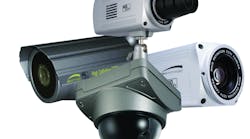The National Football League has changed the security industry. No, this is not a metaphor for how the offensive line protects its quarterback, nor is this a set-up to write about extraordinary security measures taken at the Super Bowl or at the newest stadiums across the country. This has to do with image quality.
By most accounts, the NFL was a pioneer in broadcasting its games in high-definition, causing a surge in flatscreen sales from its fans across the country. In fact, according to HDsportsguide.com, the last standard-definition broadcast NFL game was in Week 17 of the 2007 season. Fans, team owners and sports programmers agreed: Life is better in high-def.
Today, high-definition video is everywhere — from the big screen to YouTube. It has even made its way into security command centers at schools, hospitals and police stations. IMS Research recently predicted that high-resolution cameras will make up 50 percent of the IP market by 2014 — but based on sales trends and customer demand, many on the manufacturer and integrator side think it will be sooner than that, perhaps even in 2011.
As more and more security departments upgrade systems from analog to IP, the opportunity to have “HD” surveillance video resonates well with the average security director who is, like everyone else, also a home entertainment consumer. But with the sudden rise in high-definition products (and subsequent vendor marketing), it is easy to become confused when deciding what cameras to buy for specific security applications.
What exactly is HD?
Would you believe the term “HD” was actually born in the analog days? In the analog world, “HD” was used to describe cameras with 540 TV lines — a step above 480TVL. When a security camera is said to have HD-performance, end-users may assume that they will experience the same quality video as broadcast TV or Blu-ray movies. But be wary of marketing hype — the term HD does not mean anything for the security director regarding video quality.
The Truth Lies in HDTV
While the term HD means nothing to image quality, the term HDTV means everything. HDTV is a broadcasting standard governed by the Society of Motion Picture and Television Engineers. When a video stream is HDTV, there will be four distinct factors that make up image quality: 16:9 aspect ratio, full frame rate video (30 fps), guaranteed color fidelity and 720p or 1080p/i resolution.
Each factor provides a significant advantage for security. Wider aspect ratio (16:9) ensures that the video is not wasted on the sky or the ground, but instead focused on the landscape viewing area where the action happens. Full frame rate gives a realistic depiction of the scene and provides every-frame detail instead of the choppy video that many security staffers are accustomed to at low frame rates. Guaranteed color fidelity ensures that colors on the screen are a true representation of the scene, without any washing out or artificial enhancements. This could be the difference between incorrectly identifying a perpetrator wearing a pink jacket when they were actually wearing red. And resolution is obvious, as more pixels mean more detail.
If even one of these four factors is not met, then the video is not HDTV-compliant. This standard is what governs the entertainment industry’s video performance and the same quality is found today in many surveillance control rooms.
Where Does Megapixel Fit In?
Megapixel is an easy term to remember, because it only refers to one specific piece of the image: the number of million pixels in the image. Megapixel is a term more aptly used in the still photography industry, because it does not mean anything for frame rate, aspect ratio or colors in the scene. Because of this, a camera that has higher megapixel performance does not necessarily mean it will provide better overall video quality than a camera with lower resolution running in HDTV.
Still, megapixel cameras have had a major impact on the IP-based video market because more pixels mean more detail — especially during forensic searches. However, the lens is often the most limiting part of a megapixel system, making three- and five-megapixel camera performance feasible today if a more expensive megapixel-rated lens is used. There is an obvious place for megapixel in network video, but end-users should realize that it will typically come with a tradeoff of lower frame rate because of bandwidth constraints.
High-Resolution in Analog: HDcctv
For those with analog-based systems who have been following market trends, a fourth higher-resolution option seems to have arisen: High-Definition Closed Circuit Television (HDcctv). HDcctv, sometimes called “analog megapixel,” is based on broadcast engineering standards like HDTV, except its claim to fame is that video can be sent over existing coax cable so analog users can finally get a taste of high-resolution image quality.
The main problem, however, is that new equipment — such as HDcctv-compliant cameras and DVRs — must be purchased in order for the system to work. It is true that the end-user will save on up-front installation costs if their coax cable is of high enough quality to transmit the HDcctv signal, but additional hardware costs could make HDcctv less cost-effective than a network-based system. In that case, it begs the question: Why wouldn’t you upgrade?
Not only is cost a factor, but so is scalability, availability and performance. An HDcctv user will be clinging onto an outdated infrastructure format (coax) and delaying an inevitable upgrade to UTP cabling, which is actually less expensive today. Higher resolution is just one reason to select IP-based video, joining common off the shelf (COTS) storage and networking hardware, video intelligence, Power over Ethernet, audio, remote zoom and multi-streaming as unique benefits. Additionally, HDcctv products are scarce today and are expected to be quite costly thanks to low volumes. Finally, much more R&D effort and funding is being put into IP by the major manufacturers, so HDcctv and its users will have a hard time keeping pace with performance innovation.
Based on today’s usage and tomorrow’s predictions, HDTV and megapixel network cameras seem to be the only real options to consider.
Megapixel vs. HDTV: Which is Best?
Because of its standards-based approach, network cameras that operate in HDTV will oftentimes be more eye-pleasing than megapixel, and it has turned into a popular settings request from end-users in all industries. Still, there is a place for both technologies in video surveillance. Fortunately, megapixel cameras today can be manufactured to have an HDTV-compliant video setting. So, for example, the end-user can choose to record video in 3MP or 1080p based on need.
The HDTV setting is typically the most valuable in surveillance because it provides the most accurate real-world representation of the scene, including movement of people and objects in the field of view. Casinos, retailers, schools, city surveillance centers and transportation stations tend to benefit most from the HDTV format because of the fast-moving nature of the scene, as well as the need to identify specific colors — i.e. a red vs. pink chip on a table or a lost child wearing a green jacket. Additionally, a wider field of view will help put more pixels on target, and a 16:9 view can also be flipped using software to provide a 9:16 view that works extremely well to monitor shopping aisles, school corridors and train tunnels/platforms.
If, however, lower frame rate is not an issue and your application (or corporate policy) calls for super-fine detail, selecting the megapixel option might be the right one. These are for slower-moving scenes where identification — especially in post forensic searches — is of vital importance. A bank lobby, hotel front desk, access point or customs registration area could be installations where a three- or five-megapixel setting works best.
But even though it is natural to want the biggest and best, keep in mind two things when purchasing a megapixel camera. First, lenses are extremely important. A poorly matched lens will result in a poor image. While image sensor technology today can produce 10-plus megapixel performance, lens technology has not yet caught up. With advancements such as P-Iris control, the best lenses today are rated to efficiently work up to five megapixels before the image begins to degrade. The best option is to select a megapixel or HDTV camera that ships with the appropriate lens pre-configured. If that is not possible, ensure the lines per millimeter of the image sensor matches the performance rating of the lens.
Second, sometimes too many pixels can actually be overkill. Based on typical identification needs of security departments, a 6mm lens and a 1/3-inch sensor chip produces images good enough to identify a person at the following distances: VGA (10 feet), 1.3MP (20 feet) and 5MP (44 feet). In other words, in a 10-foot room, even VGA resolution would be adequate for identification.
Additionally, some megapixel cameras offer multi-view streaming, meaning that just one megapixel camera can isolate different video streams and, in essence, create several virtual cameras (HDTV can do this as well). This solution has been used in retail outlets to have one camera monitoring several registers.
Also remember that low-light performance can suffer with a higher resolution because less light is available to activate the many pixels on the sensor. So, if you require a camera in a low-light setting, make sure to field test that the higher-resolution camera has the lux level for your scene — do not rely solely on data sheet specs.
Real-World Scenarios
Application: A company needs to monitor who is coming in and out of a computer storage room. It is a very low-traffic area, but security needs to be able to clearly identify the person in the scene when the access control system is activated.
Technology: Megapixel. While HDTV in a flipped 9:16 format would work well for this situation, there is no need to deliver 30 fps at all times to monitor this doorway. Also, if real-time and post-forensic identification is important, the office security staff needs all the pixels it can get. Storage concerns can be alleviated if they record on movement or integrate the camera with the access control system to record when the door is opened.
Application: A hospital suspects that certain drugs have been disappearing from its pharmacy. They plan to mount a camera to monitor the pharmacists and nurses behind the counter as well as identify people who request prescriptions.
Technology: HDTV. Since the bottles are small and can be passed quickly between people, a high frame rate will be important. Also, if the camera is installed at the proper angle, not only will this wider view enable security personnel to see behind and in front of the counter, but they can also zoom in forensically on the computer screen during a transaction to ensure the proper drugs were entered into the system.
Application: A busy, outdoor common area is a place where students congregate. There have recently been fights there, and the campus police sometimes find it difficult to identify who provoked the fight in the sea of students.
Technology: HDTV. The 16:9 view will give a great overview of the outdoor common area, since the sky is not an important area to record. With many people moving in and out of view, full frame rate will help campus police identify people moving throughout the crowd. Additionally, if someone in a blue jacket instigates the trouble, the central station can dispatch others to look for a specific-color jacket without hesitation thanks to the format’s guaranteed color fidelity.
Application: A company notices that someone has been illegally using its dumpster at night. The company wants to install a camera above the wall directly behind the dumpster, but it does not want to install any artificial lighting.
Technology: Neither. Because of the low-light problems presented in the scene, a VGA or SVGA camera with exceptional low-light performance might be all that the company needs. Additionally, since the installation point is directly behind the dumpster — presumably only five feet from where the perpetrator would be standing — a standard resolution image should provide enough pixels per inch for identification at that distance. ?
Fredrik Nilsson is general manager of Axis Communications and author of the book Intelligent Network Video. A regular contributor on topics of networked surveillance, his popular “Eye on Video” series can be found at SecurityInfoWatch.com.
Video Surveillance
Fredrik Nilsson
March 15, 2011
Video Surveillance
Axis Communications
Sept. 22, 2006
Sponsored Content
Integrators
Everon’s Circle of Trust
April 18, 2024




